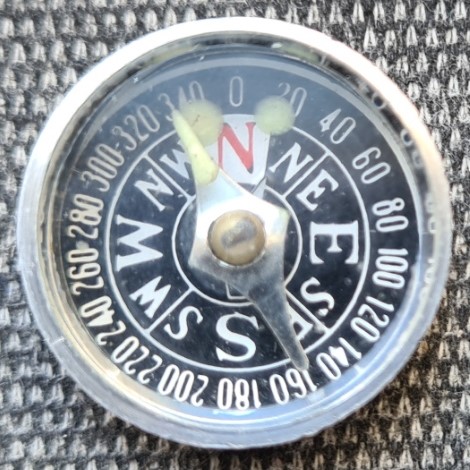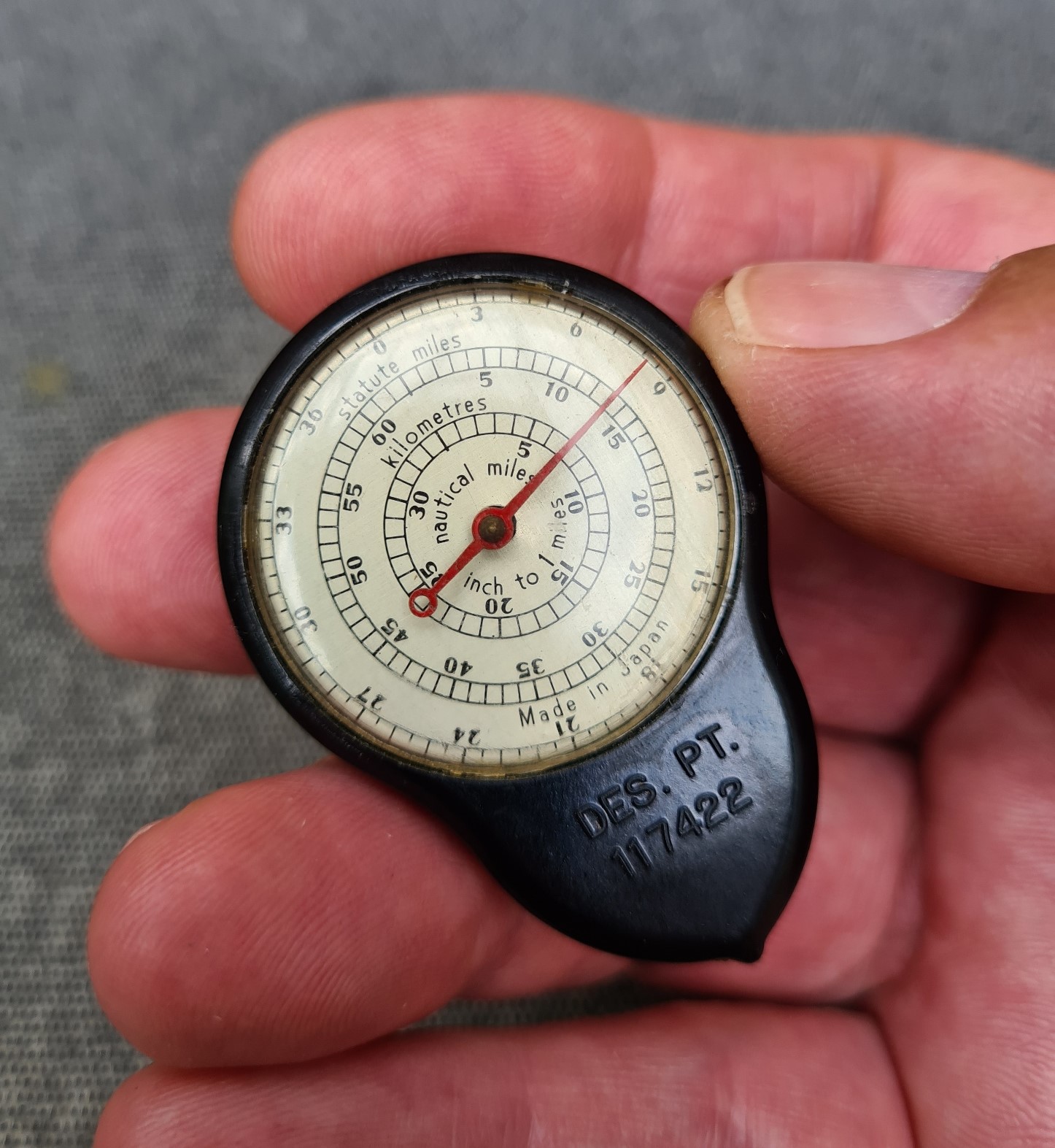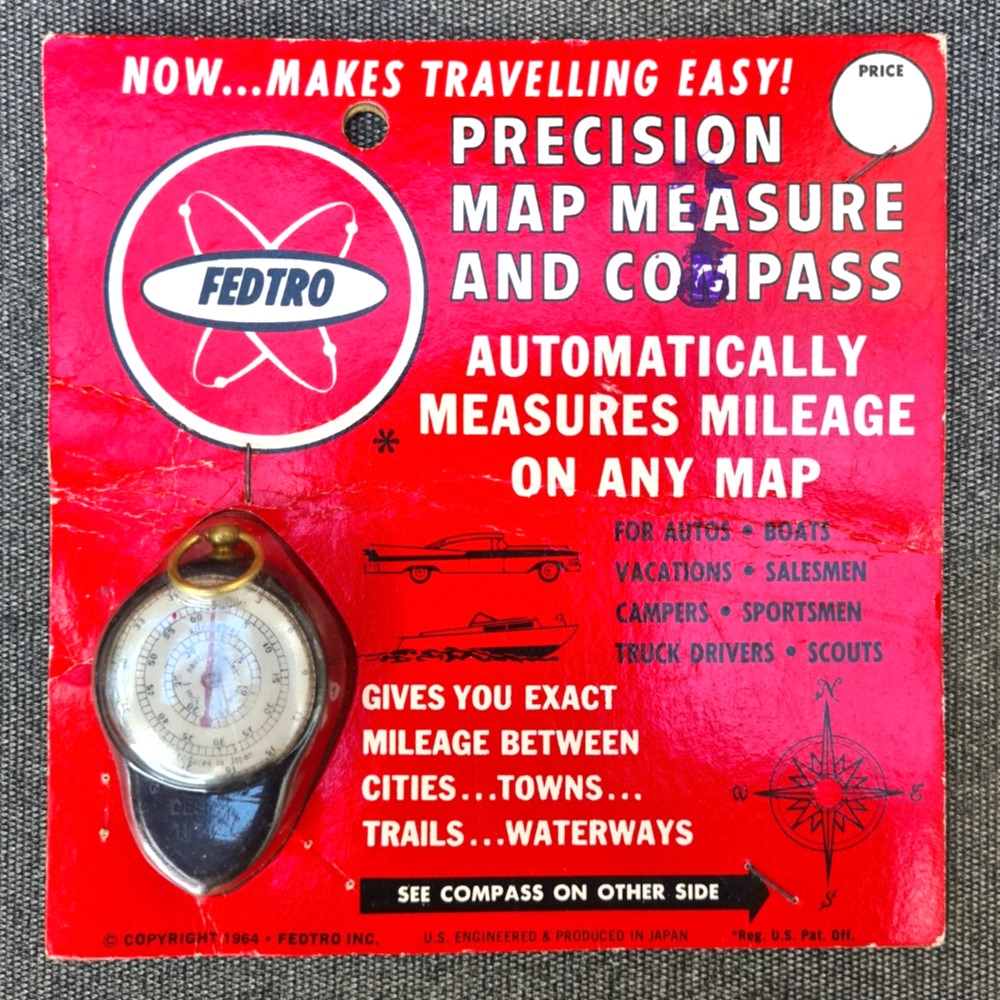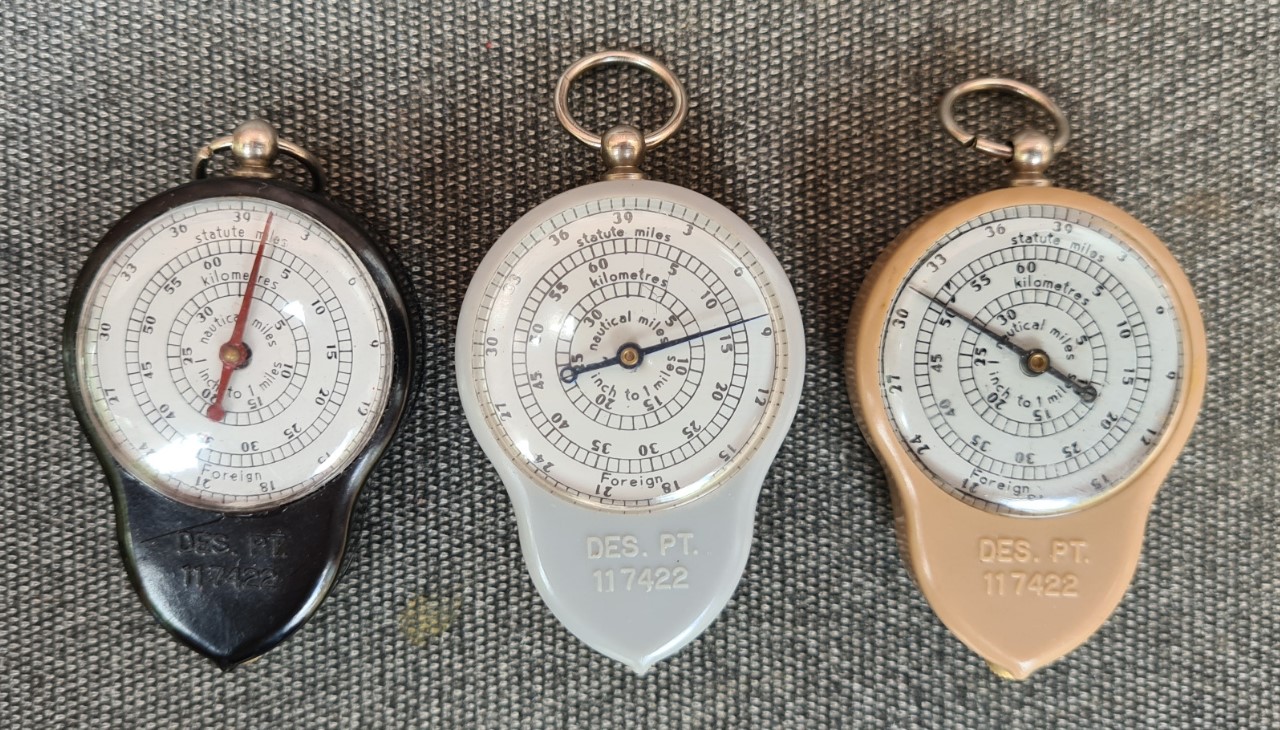These are almost identical Japanese made map measures sold by three companies, on opposite sides of the Atlantic.
In the mid-twentieth century Japan’s economy was almost destroyed as a result of their involvement in World War II. Following the war, Japan built new factories and worked hard to create efficient world-class, often world-leading, manufacturing that incorporated innovation, modern materials, fine manufacturing tolerances, good quality control and employed a trained, well-educated workforce. Aided by vision, state subsidy and support, they looked to the global market and produced vast quantities of relatively low-cost high-quality items. This produced a burst in the national economy that could barely be matched by other war torn countries and overseas manufacturing bases that still adhered to pre-war work practices.
This month’s map measure is typical of the type of cheaply made product exported by Japan in the 1960s. It is most commonly seen as a little combination map measure and compass. While simple, it worked in the same way as many a more expensive metal measure from the competition, if not to the same degree of accuracy. Manufacture of this primarily plastic measure cost a fraction of the traditional instruments that were still being made in the same way they had since the previous century. The case is plastic, including the clear plastic face to the dial. Cheaper alloys are normally found on this measure, though not including the internal mechanism, where brass is used. Japan did make very well constructed and more accurate metal measures themselves, such as the Sakurai and Lutz measures, that have previously appeared as Map Measure of the Month, but at first, they built a large customer base with lower cost items such as this month’s example.
This is a small measure. The plastic case measures 50mm x 35.3mm x 17.5mm (14.4mm if no compass and a plain back). Weights vary, from around 17g to 21g. There is normally a simple metal hanger ring screwed into the top of the case, but not always. It was available in various colours, I have seen black, white, grey, cream, a pale brown and red. Three of these variants are shown here.
There are a number of differences that can be found with this measure. Needles on the measuring dial can be red, black or blue. The dial surrounds are usually alloy but earliest versions retailed by Fedtro have what appears to be a more expensive to produce brass compass dial surround and hanger. While the combination measure/compass is by far the commonest version seen, the measures retailed by Chadwick-Miller had either a plain back, or a swing out magnifier over a plain back. All retailed versions have three measuring dials: statute miles, kilometres and nautical miles, one inch to one mile. US packaging includes the US spelling of ‘kilometers’ rather than the international spelling ‘kilometres’ shown on the instrument itself.
The measuring dial itself is not, as you might expect, a piece of paper. Instead, it is a properly paint-printed metal disc. Sadly, it is not the most accurate of measures. Rolling forwards (there is an internal pawl that prevents it being rolled backward) a measured 39 inches indicates 37.5 inches on the dial.
The compass is not much more than a toy. Unsurprisingly on such a cheap instrument, it is not liquid filled so there is no damping effect on the needle. Both cardinal/intercardinal and 20° increments are indicated on the compass and there are luminous dots on the north point of the needle and each side of the 0° North point on the compass dial. The compass does, unlike the measuring dial, have a glass crystal.
“Made in Japan…”
Since 1891 the McKinley Tariff Act required items imported into the United States to be marked, in English, with the country of origin. The dial in these measures has a varied ‘country of origin’ printing at the bottom depending on the retailer: “Made in Japan” for Chadwick -Miller, “Produced in Japan” for Fedtro, “Foreign” for Stesco. Often this simple text format is either a subtle attempt to hide true country of origin to a buying public perhaps still bristling with resentment against an old foe, or a legal requirement.
“Japan” was a simple country of designation marking from 1921-1941, but multiple examples of products without this marking originated from that country. In general “Made in Japan” was used on products after 1941 however there are again multiple examples of manufacturing where this isn’t the case. “Produced in Japan” suggests that Japan was the originating country for the materials used in the construction of the measure, made there to a US design brief. US Customs regulations stated that items intended for export to the US post-World War II were required to include the words “Made in Occupied Japan” from 1945-1952 after which the San Francisco Peace Treaty came into effect, though yet again many exported items did not include this designation despite the regulations. I have seen no examples of this measure with this text which helps suggest that export of this little measure isn’t pre-war, nor is it immediately post-war and didn’t commence until the 1960s. This is borne out by dated packaging, shown below. Production and sales may have continued in to the 1970s.
Chadwick-Miller Inc. (CMI)- Mileage Meter
The version of this month’s measure retailed by Boston based Chadwick-Miller Inc was the simplest of them all. It had a measuring dial on the front, and nothing else, not even a hanger. The company did not manufacture goods. Instead they imported many low cost items and stationery items from Japan and other overseas manufacturing bases, then rebranding them under their own identity. The Chadwick-Miller company was dissolved in 2007. Chadwick-Miller sold a number of different map measurers, such as the Roller Rule, patented in the U.S., but imported from Japan and sold in the late 1940s/50s. That attractive instrument has previously featured as Map Measure of the Month.
There were two forms of packaging for their simple “Mileage Meter”. One was a simple card box, the other was a card hanger with plastic ‘blister’ encapsulating the measure. Only the card provides a model number: ‘73129S’. Both show country of origin as Japan.

Chadwick Miller also retailed another variant of the Mileage Meter that also lacked a compass, with a plain back but included a swivel out plastic magnifying glass. This was given product number 90278. The larger box it came in had a slightly different design to that provided with the plain measure. This combination instrument also came with a vinyl case, possibly to reduce the chance of damage to the vulnerable magnifier.

Fedtro- Precision Map Measure and Compass: model MAP-C2
“Now, makes travelling easy!”
Based in Long Island, New York, USA, Fedtro Inc. engineered and produced their own home-grown products. while also importing electronic goods such as megaphones, house and car alarms, intercoms and parts for radios from Japan. As we have already seen, this month’s measure was just such a rebranded Japanese made product. The packaging for the Fedtro branded examples shown include the statement “U.S. engineered & produced in Japan“.
The distinctive Fedtro trademark was first used with one of their map measures in 1962, however they never actually registered the mark until 29 August 1967. The address of the registrant at that time was: Fedtro, Inc. Corporation New York 24 Maple Avenue. Rockville Centre New York.
Between 1965 to the early 1970s, Fedtro’s advertising frequently carried endorsements from Mickey Mantle (1931-95), a professional American baseball player with the New York Yankees. The card and plastic blister packaging for the combination measure was changed to reflect this. While Mickey Mantle did not appear on the specific packaging for the measure, this was changed to the monochrome with red highlights design that had taken place across all Fedtro branded product packaging.

Stesco- Map Measure with Compass No. 39
Stesco was a brand name for I & M Steiner, of 358-362a Kensington High Street, London, W14. They sold electrical goods in the 1930s and 1940s, When they appeared at the British Industries Fair at Olympia in 1947, they were listed as: Manufacturers of Electric Lamp shades, Standard and Table Lamps, also Electric Novelty Lines in Plastic, Skin, Paper, Parchment, etc. They moved into retailing sporting goods imported from overseas countries such as Germany and Japan. In the aftermath of World War II products obviously originating from those countries were frequently unpopular with a buying public and were instead often marked as ‘Foreign’ to disguise the specific origin. Stesco retailed this little instrument as their “Map Measure with Compass No. 39“.

In contrast to the more brightly printed US packaging, the Stesco No. 39 measure was very simply packaged. It came in a plain two-part card box with identifying paper label pasted to the top, and a simple set of instructions for both measure and compass. The slip of paper these are printed on measures 93mm x 41mm.
……………………………………………..
Almost all versions of this measure include the design patent number in the plastic moulding: “DES. PT. 117422”. The combination measure/magnifier from Chadwick-Miller does not include this.
“Patents and/or design patents for this product have been registered by the manufacturer in the country of origin”
from Fedtro packaging for Precision Map Measure and Compass
This measure must have been produced in the hundreds of thousands as multiple examples survive. However they are not always in the best of condition. Metal hangers are often broken or missing. The plastic case is often found broken or separating. The metal measuring dial frequently lifts, jamming the needle and preventing it rotating. The plastic face, I hesitate to call it a crystal, is often scratched or either loose or missing. Internal mechanism is also often not working. But, every now and then, an example is found in pretty good working condition. Testament to either careful ownership, or a simple design with cheap materials that actually worked.
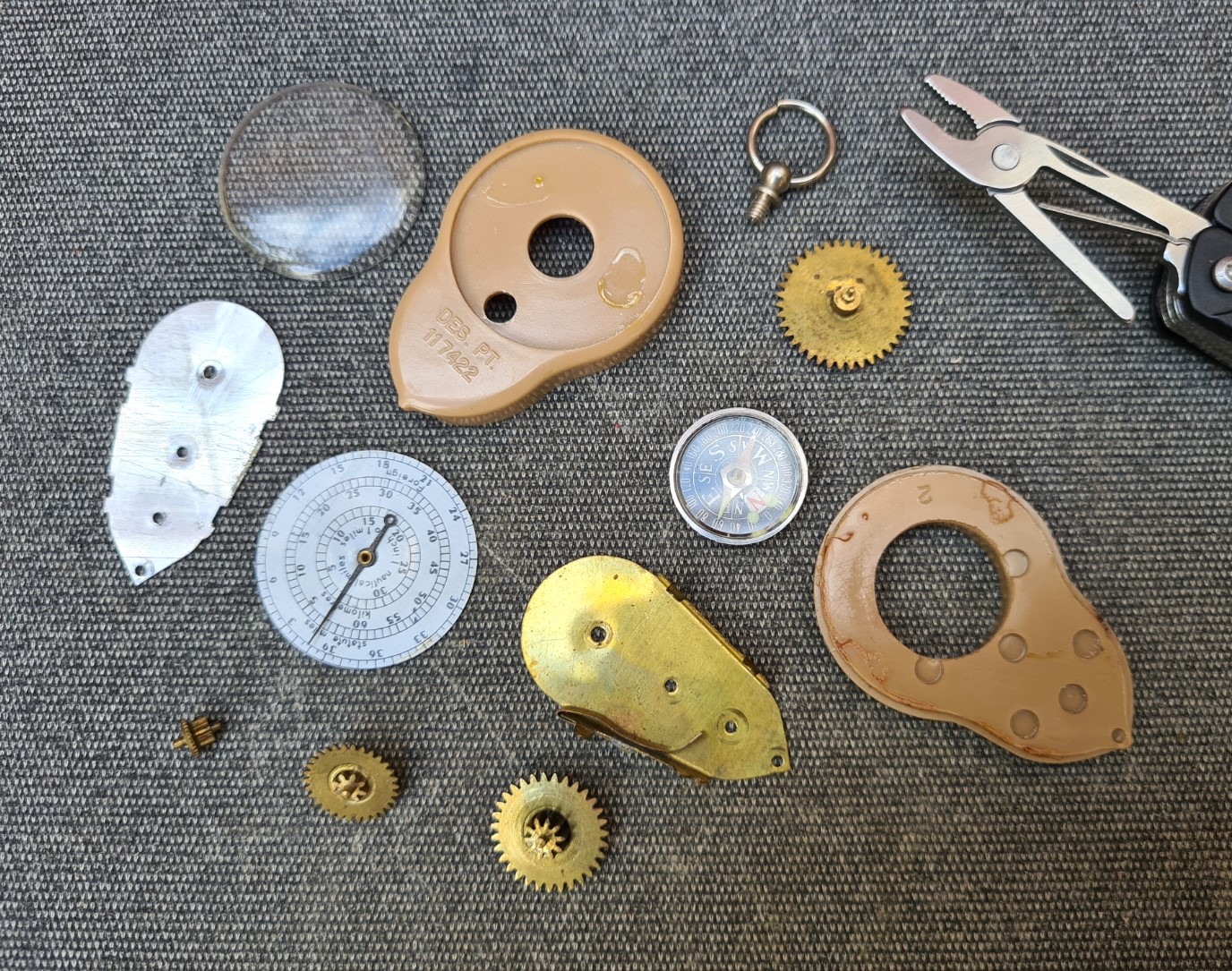
I am unsure what the “Japan H.M.” on the rear of this measure indicates. ‘Japan’ certainly means it was manufactured in Japan. On many other objects manufactured in Japan, the letters that follow the word Japan often signified the city and/or manufacturing plant from which it originated. Whether that is the case with this measure I don’t know. If any reader does know, please do add a comment.
Three Points of the Compass has looked at a few more Map Measurers in detail. Links to these can be found here.



